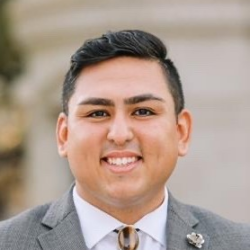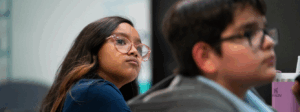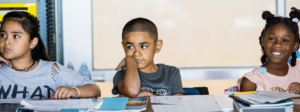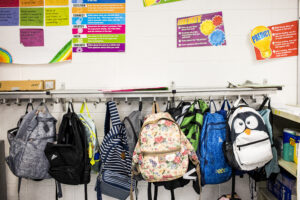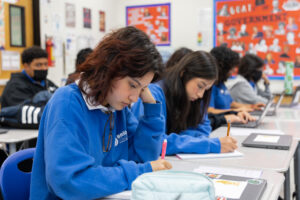Growing up in Southern California, “Hispanic” Heritage Month was not something I was aware of. In fact, it wasn’t until I went to college that I learned about it. There were no memorable mentions of Latinos in elementary or middle school textbooks. I did, however, go to a high school that celebrated the diversity of students’ cultures regularly. As a product of a subtractive schooling experience, I have come to realize that celebrations of culture can often be done at a surface level. These celebrations never truly let me go deep into the own intersections of my identity in relation to the spaces and places I’ve been. In many ways, I felt robbed by my own educational experience, and this has also helped me reclaim my own identity as a bilingual, gay, Latino, first-generation college graduate, son of immigrants, and educator who grew up in Section 8 housing who has experienced economic mobility.
It was tough to know my own family’s history, having never asked my parents where my grandparents were from or how they got to this country. Those things were left unspoken when I was a kid. We came to this country so that we could have more opportunities. That’s all I knew. As a proud Latino, Chicano, and Mexican American adult, I have taken a bolder step to learn my family’s origins and to learn everything I can from my parents and family. They instilled in me the importance of being buen educado, hardworking, resilient, and to always give back to my comunidad, which is how I chose to become a teacher.
When I first arrived in San Antonio more than a decade ago as a dual language teacher, I recall telling someone that I was from California and they said, “Oh, so you’re one of those California Chicanos, right?” I was slightly taken aback as this person was also Mexican American. However, though we shared a heritage, my lived experience as a first-generation college graduate and son of immigrants was very different from her experience as a multigenerational Texan. Through that encounter, I quickly gained an understanding of identity through the “Hispanic” lens in San Antonio—something I was taught was an antiquated and challenging word due to its origins and use.
Like many around the country, folks in our community know there is complexity in the language we use to both personally identify and in the ways we are lumped together, despite the historical, linguistic, and nationality differences. We are not a monolith. Not to mention the role colorism and being “white passing” hold in the other challenges our community faces. Plus, the challenge of how people can struggle with their place in the community based on their ability to speak Spanish, which there is a whole history on the linguistic terrorism and the removal of language by design. Si nos cortan la lengua, nos cortan la cultura y las raices (if they cut our tongue, they cut our culture and roots). As poet and activist Gloria Anzaldua says, there is un herida abierta, an open wound along the US/Mexico border around language. I’ve seen this open wound over and over again in my last 13 years in education. There’s immense pain in individuals being punished verbally and physically in schools for speaking Spanish.
As the years go by, I have become increasingly attuned to the leaders and experiences, both present and past, that have shaped our collective identity. It’s hard to think of San Antonio and not also think of the Alamo. In more recent movements to Forget the Alamo, there has also been a push to bring more of our history to the surface because it exists. I was privileged to do work as a dual language principal to support and sustain Mexican American Studies at our school, along with a Mexican American Studies Leadership Institute we launched pre-pandemic in San Antonio ISD. I realized from my experiences as a school leader that all parts of my identity have played a role in how I showed up to the work. It was because I did not have these deep, enriching experiences that I wanted to create these spaces and affirmations to identity. Whether it was through leveraging my two languages, being an advocate for queer and trans children, or serving as a bridge to families who were undocumented, I can’t help but always carry my identities close to my heart and my work.
Through this work and my own curiosities in history, I have learned more about the full story of Cesar Chavez and Dolores Huerta. I have read the autobiography of María Antonietta Berriozábal. I have learned about Emma Tenayuca y Gus Garcia and Willie Velasquez. I listened to the incredible Rosie Castro and came to see the history of the historical Edgewood case and the often forgotten Lanier walkouts. Youth have been at the forefront of these movements time and time again. And while I still struggle to see queer Latinx folks represented more broadly, allí la llevo con Gloria Anzaldúa y Gabby Rivera and in shows like Pose, Gentefied, and Love, Victor. There is complexity and richness in all parts of identity.
With all of this in mind, I am left wondering: what does it mean to be me, at this moment in time? What role can we play in this continued work that is both defined and undefined? It’s great that I’ve been able to learn more about my history and our communities’ resilience, activism, and to connect with more present-day Latinx leaders, pero todavía nos falta.
Part of what led me to join TNTP last year was grounded in the incredible community I’ve had in San Antonio and the immense potential to impact more students, schools, and communities. At TNTP, I am driven by the mission to end the injustice of educational inequity for all students with a focused view of our multilingual learners and emergent bilingual students. Through the work I am now doing, I see the critical importance of learning more about each community we serve in and to use that as a guide for how we approach our work.
That’s why as I reflect on the importance of intersectionality, I recognize the histories and cultures of the places we are privileged to serve through TNTP. I chose to work in the Southwest over a decade ago and am continuously in awe of what I learn about myself and why I do this work. We must lean into the fullness of our stories, the stories of our families, and the truths of knowing we’re standing on giants to keep the work moving forward.

